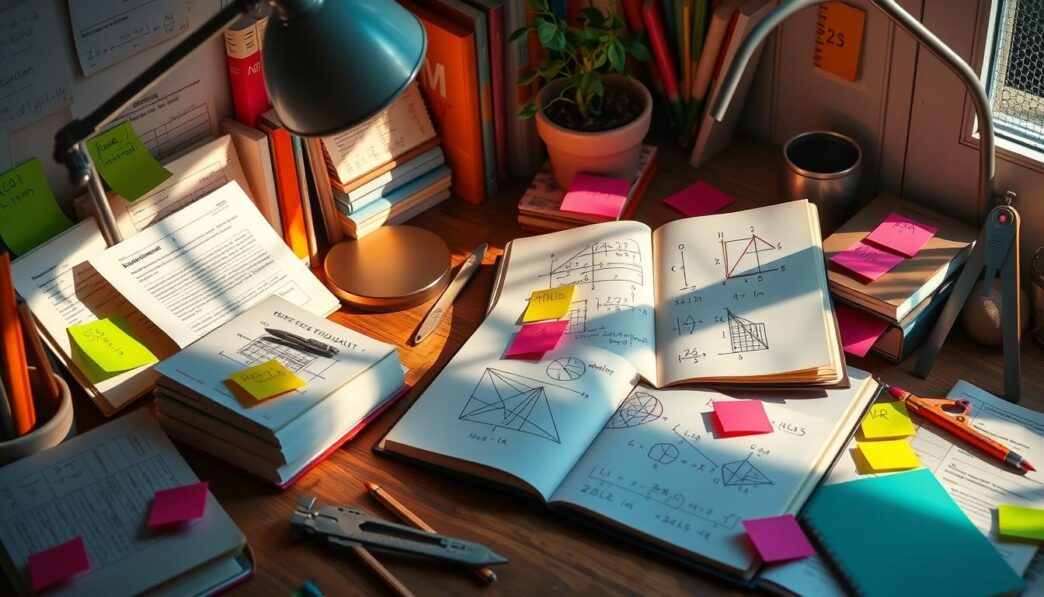The joy of cracking math Olympiad puzzles isn’t just about winning. It’s also about the thrill of solving hard problem-solving strategies. Winning an International Mathematical Olympiad (IMO) medal, like Ho Jun Wei did, shows the power of good Olympiad preparation.
Prepping for math contests is like athletes training to be their best. Participants in contests like the Singapore Mathematical Olympiad (SMO) practice a lot. This training helped Ho Jun Wei a great deal. It builds a wide knowledge of math, from smart methods to how to prove things. This is key to tackling the tough math Olympiad tips and challenges.
Looking at past data and teams from the US IMO in 1983 and 1984 shows how basic knowledge is crucial. Sometimes, you can solve complex patterns with simple math, without needing hard theories1.
Key Takeaways
- Embrace consistent practice to build a robust mathematical toolkit.
- Enhance problem-solving intuition through familiarization with basic proof techniques.
- Invest time in understanding how simple strategies apply to complex problems.
- Focus on the efficacy of fundamental theorems and techniques for problem resolution.
- Explore previous Olympiad problems for insights on pattern recognition in sequences.
- Examine contributions from past IMO participants for historical perspectives on problem-solving.
The Art of Preparation for Math Olympiads
Preparing for the Math Olympiad involves tough challenges that need a strong plan and lots of practice. Getting into the habit of Math Olympiad practice helps improve your math reasoning and solving tough problems. This is key to doing well.
Practice Is the Key to Success
Practice is super important for getting good at solving the tricky problems found in competitions like the International Mathematical Olympiad (IMO). For example, about 25% of participants couldn’t solve even one problem, showing the tough challenges they face. So, it’s crucial to keep practicing and applying mathematical theorems2.
Understanding the Importance of Basic Theorems and Techniques
Knowing basic theorems like Fermat’s Little Theorem and the pigeonhole principle is a game-changer for problem-solving. These theorems are crucial for breaking down cases and have led to incredible solutions in the IMO’s history, which has grown from seven countries to over a hundred3.
Applying Small Case Testing for Bigger Problems
It’s smart to start with simple examples to fully understand a problem before moving to harder cases. This approach helps when facing the tough problems in the IMO, designed to test the best students3.
| Year | Participants | Medal Expectancy |
|---|---|---|
| Upcoming 2024 IMO | Over 600 | 50% or fewer |
| Participation Trend | From 7 countries in 1959 to over 100 in recent years | Gold, Silver, Bronze in 1:2:3 ratio |
| Nepal’s Selection | Top 6 from TST | Advancing to consecutive rounds |
Learning these preparation techniques and looking at past competition stats help prepare for the challenges and teach about effective strategies and mental readiness for Olympiad success32. Every hurdle in Math Olympiad practice is a step towards greater success in the actual competition.
Essential Theorems and Lemmas for Olympiad Problems
If you’re aiming to excel in math Olympiads, knowing essential mathematical theorems and foundational lemmas is crucial. Mastery in these areas is key to tackling the tough puzzles you’ll face. These competitions require a deep understanding of theorem mastery and lemma application.
Learning and Memorizing Fundamental Theorems
The Fundamental Theorem of Arithmetic and Bezout’s Identity are vital for any math Olympiad contender. Understanding these theorems improves problem-solving skills. For instance, page 22 dives into number theory basics, while page 16 focuses on solving equations4.
Euler’s Totient Theorem and Fermat’s Little Theorem are also crucial. Introduced on page 45, they help solve many number-based Olympiad problems4. They’re practical tools, essential for competitive success.
Building a Strong Foundation with Lemmas
Lemmas may not be as formal as theorems, but they’re incredibly useful. They help competitors through Olympiad problems. For example, p-adic valuation techniques are discussed on page 69, aiding in solving complex equations4.
Using techniques like barycentric or Cartesian coordinates helps solve geometry puzzles. This shows the practical side of lemmas5. Such applications deepen theorem mastery.
| Theorem | Page | Description |
|---|---|---|
| Fundamental Theorem of Arithmetic | 22 | Base for understanding number structures |
| Euler’s Totient Theorem | 45 | Used in modular arithmetic applications |
| Fermat’s Little Theorem | 45 | Important for calculations in prime moduli |

Mastering these math principles isn’t just about hard work. It’s about building a smart strategy of learning and applying knowledge. Keeping up with various math Olympiad resources is key. This ensures you’re ready for any challenge you might face.
Developing Strong Problem-Solving Techniques
Getting good at math contests like Math Olympiads blends theory and practice in unique ways. This mix helps learners use knowledge, strategy, and deep thinking to excel. It’s crucial for winning in high-level math contests.
The Power of Factorization and Elementary Methods
Understanding mathematical factorization and basic techniques is key to solving problems well. For example, many Math Olympiad problems need simple yet smart strategies that use factorization. This is often marked as crucial for solving complex number puzzles6. These methods help break down big problems into smaller, more manageable ones. This change can make the ‘impossible’ suddenly doable.
Frequent practice is also important. Top contenders train for several hours every day. This effort boosts their analytical skills. It helps them win big, like getting Gold medals at worldwide contests6.
These basic methods are used in creative ways for Olympiad problems. They don’t always need advanced math but rather sharp observation and a solid grasp of basic ideas6.
Strategies for Tackling Polynomial and Inequality Issues
For Math Olympiads, knowing how to handle polynomial and inequality problems is crucial. Analyzing polynomial roots and linking them to coefficients offers various ways to solve problems6. Techniques like smoothing and substituting simplify tough questions. They make abstract concepts feel more structured.
These problem-solving ways not only improve skills in tackling complex issues but also encourage breaking the norm in math.
Working together in the math competition community helps everyone learn together. Sites like Art of Problem Solving are great for sharing ideas and strategies. This team spirit is unique to math contests7. It’s also seen in events like the Harvard-MIT Math Tournament. Here, it’s about more than competing. It’s about the lasting friendships that form7.
These chances foster a welcoming and helpful setting. They show the importance of problem-solving methods and the need for good communication and smart learning in advancing in math.
Solving (some) formal math olympiad problems
The world of Math Olympiads is a tough nut to crack. It’s not just regular school stuff. To do well, you need a mix of smart strategies and deep problem-solving skills.
Starting with Simplified Models to Tackle Complex Problems
Starting simple helps a lot with tough math olympiad problems. You use basic models to take a big problem and break it into smaller pieces. This way, the problem becomes easier to understand. It also points you towards new ways to solve it. Adding recent tech like AI, as seen here8, makes solving these problems even faster.
Leveraging Bounds and Construction Techniques
Using certain methods and setting limits are key in solving tough math problems. They help outline the problem, making it easier to figure out the answer. It’s not just about any answer, but about finding the best one. By understanding problem boundaries, you can quickly see which solutions won’t work.
| Strategy | Application |
|---|---|
| Utilizing Mathematical Models | Break down complex problems into simpler, understandable modules. |
| Numerical Bounds | Define limits within which solutions must fall, refining the search area. |
| Construction Methods | Build upon initial solutions to explore further possibilities. |

Solving problems in Math Olympiads isn’t just about finding answers. It’s also about understanding why those answers work. With AI and machine learning, we’re seeing new, smarter ways to tackle problems. This is changing how we approach math and could lead to more discoveries.
Overcoming Common Obstacles in Math Olympiads
Math Olympiads throw a lot of challenges at participants. These challenges can slow down their progress and lower their scores. It’s really important to know these problems to figure out how to solve them well.
Common Mistakes and How to Avoid Them
Not getting ready the right way is a big problem for many participants. Only 195 out of 539 college math departments have special courses for solving problems9. If more of these courses were available, it would help students get better at these contests. Applying problem-based learning could also make students think more deeply and ask more questions9.
Many don’t use enough different ways to solve problems, which is crucial for success in Olympiads. By offering a variety of problem-solving courses, learners of all levels could get the help they need. This could stop them from making mistakes9.
What to Do When You’re Stuck on a Problem
Using systematic ways to solve problems can really improve your chances. Experts recommend staying alert and practicing hands-on problem-solving9. This way, students don’t just learn the solutions but also understand why they work. This makes their problem-solving skills better.
When facing tough questions, try breaking them down into smaller parts. This strategy helps handle complex issues more effectively. It’s a key technique for solving problems.
Having regular tests on problem-solving can also help students get better at tough Olympiad problems9. It prepares them to face complicated questions with more confidence and skill.
To succeed in Math Olympiads, being prepared and flexible is essential. This means being ready to use old strategies or come up with new ones quickly. The key is to stay calm and focused while solving problems.
| Focus Area | Strategic Approach | Beneficial Outcome |
|---|---|---|
| Diverse problem-solving techniques | Introduction of varying levels of problem-solving courses | Broader analytical skills and error prevention |
| Active engagement in problem-solving | Hands-on, problem-based learning | Enhanced strategic thinking and troubleshooting |
| Systematic approach to Olympiad problems | Structured problem breakdown | Effective management of complex problems |
Mastering Math Olympiads means adopting a broad and strategic approach to learning and practice. Through careful preparation and a good knowledge of various problem-solving methods, facing Olympiad challenges can become something you can definitely do.
Advanced Techniques for Complex Problem Solving
Success in math Olympiads heavily relies on mastering advanced mathematical techniques and complex problem-solving strategies. It’s about more than just knowing stuff; you need to think creatively and analyze deeply. This helps you tackle tough problems even under pressure.
Taking an example, specialized AI systems like AlphaProof and AlphaGeometry 2 by Google DeepMind solve advanced problems10. They nailed four out of six tough questions at the IMO, almost winning a silver medal10. This shows how powerful superior math methodologies can be.
In these contests, a common tactic is breaking big problems into smaller, easier pieces11. Math Olympiads set up their questions expecting solutions in a certain time11. You need to think fast and calculate accurately, whether it’s in Algebra, Geometry, or Number Theory11.
Experienced mathematicians like Tim Gowers and Joseph Myers confirm the AI’s correct answers during tests10. This highlights not just the hard questions but also the chance to learn from them.
| Technique Type | Example Problem | Time Allocation |
|---|---|---|
| Algebra | System of equations | 12 mins |
| Geometry | Circumference calculations | 10 mins |
| Number Theory | Prime factorization | 8 mins |
For better skills, Olympiad hopefuls should practice like they’re in real competitions. This means tackling problems from past exams and learning from the solutions12. Regular practice and checking your work helps overcome Olympiad challenges.
By embracing complex problem-solving strategies and applying them, one can greatly improve analytical skills. This prepares you for success in school and in solving real-world complex issues.
Applying Algebra and Geometry to Olympiad Challenges
Math Olympiads need a strong grasp of algebra and geometry to tackle tough questions. This part talks about using algebra to solve geometry puzzles and the role of Gröbner bases in algebra. Gröbner bases are key in solving complex algebra issues.
Using Algebraic Structures to Decode Geometry Problems
Olympiad participants use algebra to make solving geometry problems easier. Techniques like introducing coordinates transform difficult geometry puzzles into simpler algebraic ones. This approach turns visual problems into equations that can be solved step by step.
The Mathematical Olympiad Summer Program (MOSP) trains students in these methods. They learn about polynomials and complex numbers in geometry, turning their spatial understanding into something they can calculate13.
Exploring Gröbner Bases for Algebraic Solutions
Gröbner bases are essential for Olympiad algebra. They offer a strong way to work through polynomial equation systems. This method makes it easier to handle and simplify complex algebraic challenges.
Modern computational tools also improve geometry problem-solving, using algebra to get and check answers. For instance, during IMO team choices and MOSP training, students work with Gröbner bases. They prepare for tough contests with these advanced algebra topics13.
New tools in computational algebra help test and refine algebraic methods. Mixing direct problem-solving with theory creates a strong foundation. This prepares young mathematicians for Olympiad-level puzzles.
Merging algebra and geometry broadens students’ problem-solving skills. It also deepens their understanding of math concepts, helping them excel in math Olympiads.
Conclusion
In closing this study on formal math olympiad problems, we highlight the global effort involved. Educators, students, and mathematicians from 50 countries worked together. They proposed 193 problems for the 63rd International Mathematical Olympiad in 2022. This shows the strong, worldwide collaboration in math education14.
The gathered effort led to a Shortlist with 3 Algebra, 4 Combinatorics, and 5 Geometry problems. This selection highlights the variety and complexity of math challenges14.
We also discussed the key role of personalized learning in boosting problem-solving skills. Adjusting the difficulty level helps stretch abilities. This method focuses on enhancing the quality and depth of practice15.
Looking ahead at math competitions, we see the ongoing effort to collect and polish olympiad problems. We aim to make a unique repository, separate from Mathlib. By keeping high standards and promoting thorough Lean practice, we blend tradition and innovation. Every new problem, like the Czech Republic’s C3 or the United States’ G4, presents a distinct challenge. They continue the quest for knowledge and the pleasure of discovery14.




















